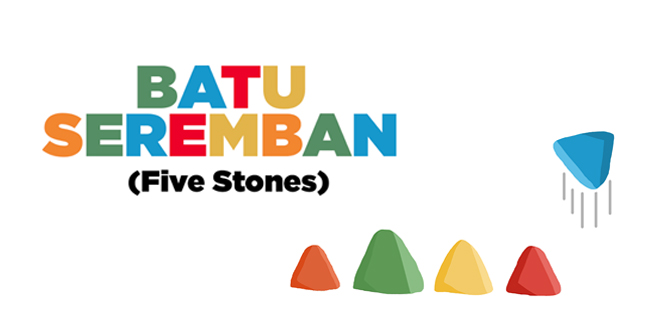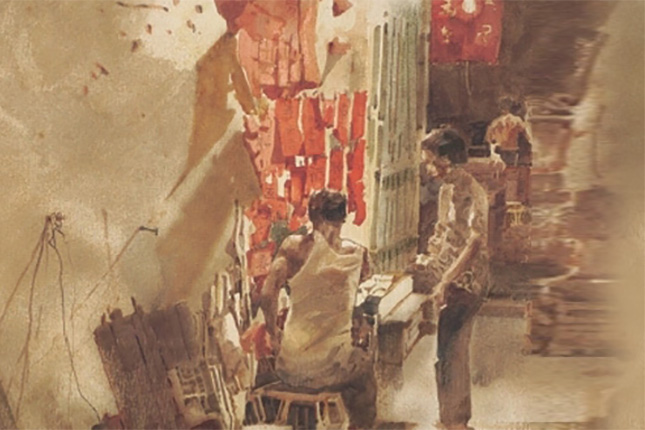This write-up was adapted from an educational booklet produced by the Malay Heritage Centre.
Yeh-Yeh (Jump Rope)

While the origins of jump rope are fuzzy — some believe it started in
Egypt while others trace it back to ancient China1 — one thing is for certain:
jump rope crosses cultures and has entertained children for millenia.
It is as much a staple activity for African American girls in modern times,
as it was for children of Medieval Europe who used to jump rope on its streets.2
Jump ropes can be made from a range of materials. The ancient
Egyptians were said to have used vines while children in more recent times
repurpose items such as clothes lines and twine. In Singapore, children used to
string together rubber bands in a game some refer to as
yeh-yeh.
Try it yourself:
Two individuals hold a piece of rope on each end. Then they swing it. A third player jumps over it.
As the game progresses, the rope is raised higher and higher until the player can no longer jump over the rope without touching it.
Some versions of the game specify six heights to clear, starting at the ground level, then the ankles, knees, waists, shoulders and ears of the individuals holding the rope.3
The player who clears the rope at its highest point wins.
To add yet another dimension to the activity,
two ropes can be put in play and whipped around while a player attempts to slip in between the lines and clear them.
Rhythms and chants can also be added to enhance gameplay.
Gasing (spinning top)

The top has fascinated both the young and old for centuries.
Archaeological digs across the world have uncovered tops fashioned out of a variety of materials
including conch shells, seed pods, ivory and iron.4
Closer to home, the game’s popularity has been traced back to the 15th
century during the reign of the Melakan Sultanate. Records show that the gasing served as entertainment
for rice farmers who played it during lull periods after the end of the harvest season.5
The shape of the gasing was said to have been inspired by the fruit
of the berembang tree which tapered off at its tip.6 It tended to do well on hard and sandy surfaces.7
In Singapore, gasing was played across kampongs islandwide.
Try it yourself:
Tops are designed to spin rapidly while balanced on their tips. All it takes is a simple flick of the wrist to set the top in motion.
Others might need to be wound up via a string around their axis and then released quickly.
The player who can keep his or her top spinning the
longest, or strike and stop the trajectory of another top in play, wins.
Tie a string tightly around the top of the gasing.
Throw the gasing and release the string at the same time. Carefully transfer the top onto a wooden panel.
In another version of the game, players have to strike and topple each other’s tops. The gasing
that survives or spins the longest, wins.
Capteh

With acrobatic hurricane-whirl kicks and mesmerising moves inspired by natural predators such as the snake, tiger and leopard, the Shaolin monks are renowned as impressive martial artists. What few would believe is that generations of them had used the humble
shuttlecock — or capteh as we know it — to sharpen and hone their kung fu skills.8
It might seem like child’s play to get the shuttlecock off the ground but mastering special moves and keeping it airborne for as long as possible with one’s feet is a whole other ball game. An international federation has evolved the game into a competitive sport since 1999, with players battling it out on a court with a net in the middle to challenge their agility, balance and strength.
The capteh played in our neck of the woods tends to be a more casual activity. Looks-wise, it is hard to miss. It typically comprises rainbow hued feathers attached to a weighted, rubber sole.
Try it yourself:
Launch the capteh into the air with one foot and keep it
off the ground for as long as possible using either foot. A point is awarded for every successful kick.
The objective is to keep this going for as long as possible without using one’s hands.
It is a numbers game with capteh.
The more kicks executed to keep it in the air, the higher the chance of winning.
Players can also agree on a winning tally of continuous kicks to sieve out the winner.
Capteh can also be a team sport.
In this iteration, participants form a circle. The first player then steps into its centre to demonstrate his capteh abilities.
A second player takes over and so forth until all players have completed their turn.
The team with the most number of kicks wins.
Batu Seremban (five stones)

Soft little pads of beans,
rice or sand wrapped in cloth. Some handsewn, some mass manufactured.
The game of batu seremban or five stones, where the objective is to catch
counters thrown into the air, has enthralled children for generations.
The game, which requires hand-eye coordination and a
certain level of dexterity to clear its various levels, is not unique to the region.
Researchers have found evidence of it being played in ancient Greece and Ukraine.11
Try it yourself:
Throw the five stones on the ground. Then pick one up to toss in the air.
With the same hand, pick up a second stone from the ground and catch the first stone before it touches the ground.
Now, with two stones in hand, toss one of the stones into the air and pick up a third stone from the ground.
Next, throw one of the three stones in hand into the air, pick up a fourth stone from the ground and retrieve the falling, airborne stone.
Finally, throw the fourth stone into the air and pick up the final stone on the ground.
There are multiple levels to the game, each with increasing
complexity and variants of gameplay that involve multiple players.
Many Singaporeans would have fond memories of casual or competitive
sessions of five stones during their days as students.
Goli

Goli or marbles is a riveting game.
At stake are your own marbles which you bring to the arena.
Using one’s own set of glass balls, players gingerly flick, nudge and prod
competitor’s marbles away from pre-determined margins — usually a circle drawn in the sand or demarcated by string.
The game requires patience, skill and accuracy to control the
trajectory of the marbles and successfully
strike a competitor's token out of the play zone.
Try it yourself:
Draw a circle on the ground. Thereafter, get each player to place one of their marbles in the play zone.
To start the game, add two parallel lines to the ground. Players should then take turns to each throw a marble from behind one of the lines (A).
The player whose marble is nearest to the line on the other end (i.e. line B), gets to start the game.
Game play starts from line B. Each player takes turns to throw their marbles into the circle with the aim of dislodging those belonging to their competitors.
The player gets to keep the marble he or she successfully edges out of the circle. The participant who collects the most marbles wins.
Congkak

Congkak, a two-player game akin to chess, requires a fair bit of
mental agility and mathematical prowess to anticipate moves and game play patterns.
The game’s objective is to amass the larger number of seeds in your own stipulated storehouse on the board.
The board itself, typically boat-shaped with 16 hollowed out pits, deserves a mention.
Early editions used to be hand carved12 and made out of expensive woods such as mahogany or teak. More exquisite sets would feature intricate carvings of dragons or mythical birds. Cowrie shells, marbles as well as saga or tamarind seeds can be used to plug the board’s holes.
Variations of the game, which is said to have originated in the Middle East, in particular
Jordan between 7,000 BC and 5,000 BC, are played all over the globe, having been spread by travellers and traders over time.13
How it's played:
Two players sit across each other with the boat-shaped block in between.
Each player “owns” the circular holes before them (henceforth known as homes), as well as the larger pit on his or her left.
Before the game begins, each house must be filled with seven marbles. Both storehouses are left empty.
Both players then pick up marbles from any of their own houses. Going clockwise, they deposit a marble per house on the board, regardless of who owns the house, until the marbles in hand run out.
They must also deposit a marble at their own storehouses but not at their opponent's before ending the round.
Upon ending the round, a player scoops up all the seeds in the house he dropped his last seed in, and repeats the process until his last seed lands in an empty house.
-
There are three outcomes for each player at the end of these rounds:
- If the last seed falls into his own house, he can pick all the seeds from his opponent’s house lying across it and deposit them in his own storehouse.
- If it drops into his storehouse, he can continue the game, picking a house of his choice from his side to begin the next round.
- Should his last seed end up in an empty house, he is considered ”dead” and his turn ends.
The one with the most seeds at the end wins. This round is followed by two others which vary in play.
Source: Let’s Play – Traditional Malay Games @ Malay Heritage Centre (pamphlet)























